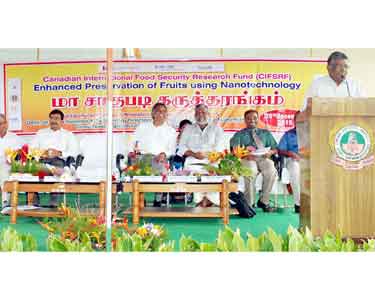400 ஆண்டுகளுக்கு முன் போர்ச்சுக்கல் நாட்டில் இருந்து இந்திய கடற்கரைக்கு கொண்டு வரப்பட்டு பயிரிடப்பட்ட முந்திரி இன்று 7 லட்சம் எக்டேரில் பயிரிடப் படுகிறது. முந்திரி வெளிநாடுகளில் இருந்தும் இறக்குமதி செய்யப்பட்டு, இங்கு விளையும் முந்திரியையும் பதப்படுத்தி முந்திரி பருப்பு, முந்திரி ஆயில் எடுக்கப்பட்டு 4 லட்சம் டன் முந்திரி பருப்பு உற்பத்தி செய்யப்படுகிறது.
தமிழ்நாட்டிலும், கேரளாவிலும் பல லட்சம் பேருக்கு இத்துறை வேலை வாய்ப்பை அளிக்கிறது. முதன் முதலாக முந்திரிப் பருப்பை ஏற்றுமதி செய்யத் தொடங்கிய நாடு இந்தியா. 1955ம் ஆண்டு இதன் ஏற்றுமதியை ஊக்குவிக்க “ இந்திய முந்திரிப் பருப்பு ஏற்றுமதி வளர்ச்சி கவுன்சில்” தொடங்கப்பட்டது.
இதன் பணிகள் : இந்திய ஏற்றுமதியாளர்களை வெளிநாட்டு இறக்குமதியாளர்களுடன் சந்திக்க வைப்பது. ஆர்டர்கள் பெற்றுத் தருவது. இந்திய முந்திரிப் பருப்பின் தரம் பற்றி வெளி நாடுகளில் பிரசாரம் செய்வது. வெளிநாடுகளில் நடக்கும் கண்காட்சிகளில் உறுப்பினர்களை கலந்து கொள்ளச் செய்தல்.
இந்தியாவில் பண்ருட்டி, கோவா, கொல்லம், ஐதராபாத், தாசர்கோடு, மங்களூர் என பல ஊர்களில் முந்திரிப் பருப்பு பதப்படுத்தும் பெரிய நிறுவனங்கள் உள்ளன. இந்த நிறுவனங்களுக்கு இந்த ஆண்டு 40 கோடி ரூபாய் மானியம் இந்த கவுன்சில் வழங்கியுள்ளது. இந்த கவுன்சில் 1977ம் ஆண்டு கேரள மாநிலம் கொல்லத்தில் ஒரு சிறந்த “CEPC லேபரட்டரியை” தொடங்கியது. முந்திரியை சோதனை செய்து தரச்சான்று தர மட்டுமல்ல பலவகை உணவுப் பொருட்களை சோதிக்கவும் பயன்படுகிறது. தரத்தை பரிசோதிக்க பல பயிற்சிகளையும் இந்த நிறுவனம் வழங்குகிறது. பலவகை, உணவுப் பொருட் களைப் பற்றி பரிசோதிக்கவும், அதன் தரம் பற்றி படிக்கவும் இந்நிறுவனம் உதவுகிறது. தண்ணீர், மூலிகைகள், மீன், பால் பொருட்கள், தேன், பழம், இறைச்சி, பேக்கரி பொருட்களை பரிசோதிக்கவும், தரச்சான்று வழங்கவும் இந்த பரிசோதனைக் கூடம் உதவுகிறது.
இந்த கவுன்சில் பற்றி அறிந்து உதவி பெற Cashew Export Promotion Council of India, Cashew Bhavan, Mundakel, Kollam 691 001, Kerala. Ph: 0474 274 2704, www.cepc.org.in. www.cashewindia.org.
கீழ்கண்ட வலைதளங்களையும் பார்த்து இத்துறை பற்றி நன்கு அறியலாம்.
www.fao.org, www.tnau.ac.in,
www.mofpi.gov.in,
www.cepclab.org.in,
www.kerelaagriculture.gov.in.
-எம்.ஞானசேகர்,
தொழில் ஆலோசகர்,
93807 55629
Source : Dinamalar
தமிழ்நாட்டிலும், கேரளாவிலும் பல லட்சம் பேருக்கு இத்துறை வேலை வாய்ப்பை அளிக்கிறது. முதன் முதலாக முந்திரிப் பருப்பை ஏற்றுமதி செய்யத் தொடங்கிய நாடு இந்தியா. 1955ம் ஆண்டு இதன் ஏற்றுமதியை ஊக்குவிக்க “ இந்திய முந்திரிப் பருப்பு ஏற்றுமதி வளர்ச்சி கவுன்சில்” தொடங்கப்பட்டது.
இதன் பணிகள் : இந்திய ஏற்றுமதியாளர்களை வெளிநாட்டு இறக்குமதியாளர்களுடன் சந்திக்க வைப்பது. ஆர்டர்கள் பெற்றுத் தருவது. இந்திய முந்திரிப் பருப்பின் தரம் பற்றி வெளி நாடுகளில் பிரசாரம் செய்வது. வெளிநாடுகளில் நடக்கும் கண்காட்சிகளில் உறுப்பினர்களை கலந்து கொள்ளச் செய்தல்.
இந்தியாவில் பண்ருட்டி, கோவா, கொல்லம், ஐதராபாத், தாசர்கோடு, மங்களூர் என பல ஊர்களில் முந்திரிப் பருப்பு பதப்படுத்தும் பெரிய நிறுவனங்கள் உள்ளன. இந்த நிறுவனங்களுக்கு இந்த ஆண்டு 40 கோடி ரூபாய் மானியம் இந்த கவுன்சில் வழங்கியுள்ளது. இந்த கவுன்சில் 1977ம் ஆண்டு கேரள மாநிலம் கொல்லத்தில் ஒரு சிறந்த “CEPC லேபரட்டரியை” தொடங்கியது. முந்திரியை சோதனை செய்து தரச்சான்று தர மட்டுமல்ல பலவகை உணவுப் பொருட்களை சோதிக்கவும் பயன்படுகிறது. தரத்தை பரிசோதிக்க பல பயிற்சிகளையும் இந்த நிறுவனம் வழங்குகிறது. பலவகை, உணவுப் பொருட் களைப் பற்றி பரிசோதிக்கவும், அதன் தரம் பற்றி படிக்கவும் இந்நிறுவனம் உதவுகிறது. தண்ணீர், மூலிகைகள், மீன், பால் பொருட்கள், தேன், பழம், இறைச்சி, பேக்கரி பொருட்களை பரிசோதிக்கவும், தரச்சான்று வழங்கவும் இந்த பரிசோதனைக் கூடம் உதவுகிறது.
இந்த கவுன்சில் பற்றி அறிந்து உதவி பெற Cashew Export Promotion Council of India, Cashew Bhavan, Mundakel, Kollam 691 001, Kerala. Ph: 0474 274 2704, www.cepc.org.in. www.cashewindia.org.
கீழ்கண்ட வலைதளங்களையும் பார்த்து இத்துறை பற்றி நன்கு அறியலாம்.
www.fao.org, www.tnau.ac.in,
www.mofpi.gov.in,
www.cepclab.org.in,
www.kerelaagriculture.gov.in.
-எம்.ஞானசேகர்,
தொழில் ஆலோசகர்,
93807 55629
Source : Dinamalar







